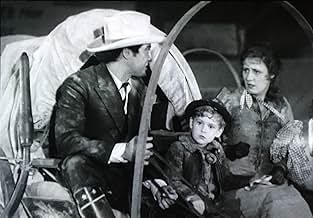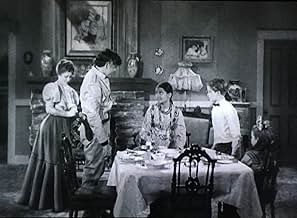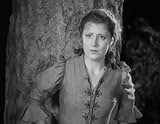IMDb रेटिंग
5.8/10
7.4 हज़ार
आपकी रेटिंग
अपनी भाषा में प्लॉट जोड़ेंA newspaper editor settles in an Oklahoma boom town with his reluctant wife at the end of the nineteenth century.A newspaper editor settles in an Oklahoma boom town with his reluctant wife at the end of the nineteenth century.A newspaper editor settles in an Oklahoma boom town with his reluctant wife at the end of the nineteenth century.
- 3 ऑस्कर जीते
- 7 जीत और कुल 5 नामांकन
Roscoe Ates
- Jesse Rickey
- (as Rosco Ates)
Judith Barrett
- Donna Cravat
- (as Nancy Dover)
Max Barwyn
- Sabra's Luncheon Greeter
- (बिना क्रेडिट के)
Frank Beal
- Louis Venable
- (बिना क्रेडिट के)
Tyrone Brereton
- Dabney Venable
- (बिना क्रेडिट के)
Dolores Brown
- Adult Ruby Big Elk
- (बिना क्रेडिट के)
फ़ीचर्ड समीक्षाएं
This is a comment following up to a previous post. Richard Dix was a big silent film star before Cimarron. He was one of the few silent actors who successfully made the transition to talking pictures. I hardly recognized Irene Dunne at first, this was only her second film. This film is fun to watch as the talent of the actors is evident. People must keep in mind that the sound quality, sets, etc. were all still relatively new in 1931. Actors and directors were accustomed to silent movies. The costumes, performances, and sets are quite good, in my opinion. Once gets a feel for how the home life, new life in the southwest, and the timeless snobbery of the town "ladies." The courtroom scenes are intense. The writing was realistic for the time period. Scathing accusatory and judgmental remarks to browbeat and break the woman's spirit. A very moving picture.
Adventuresome and scholarly Richard Dix (as Yancey Cravat) joins the 1889 Oklahoma land rush, and helps settle the territory, with loyal homesteading wife Irene Dunne (as Sabra). His oratory skills as a lawyer and work as a newspaper editor help Mr. Dix defend the downtrodden through the ensuing decades. Notably, Mr. Dix is supportive of Native American (Indian) rights. Dix also helps independent woman and presumed prostitute Estelle Taylor (as Dixie Lee). After some decades pass, we meet the title character, wild and unruly son Don Dillaway (as Cimarron "Cim" Cravat).
"Cimarron" is mostly recalled as the first western to win an "Academy Award" for best film. Some may think it should be recalled as the first time an award was given to prop up the box office of a flop. But, the red ink was due to RKO spending so much on the film; while not recouping its cost, "Cimarron" was one of the biggest box office hits of 1931. It was also a triple crown "Best Picture" award winner, with prizes from "Photoplay" and "Film Daily" included. Those awards were also the ones bestowed upon "The Covered Wagon" (1923), which was the world's previous western standard.
None of this means "Cimarron" is anything more than a swaggeringly average western, with a lot of production cost. Some of it is so dull, the "ethnic" characters emerge as most perversely entertaining. It's difficult to justify the acting nominations for Dix and Ms. Dunne. Director Wesley Ruggles manages the crowds well and adds a few artful moments, like the clever crucifying positioning of Jewish character George E. Stone (as Sol Levy), after some bullying. Edna May Oliver (as Tracy Wyatt) also makes the most of her role, employing many mannerisms seen later in Carol Burnett.
***** Cimarron (1/26/31) Wesley Ruggles ~ Richard Dix, Irene Dunne, Estelle Taylor, George E. Stone
"Cimarron" is mostly recalled as the first western to win an "Academy Award" for best film. Some may think it should be recalled as the first time an award was given to prop up the box office of a flop. But, the red ink was due to RKO spending so much on the film; while not recouping its cost, "Cimarron" was one of the biggest box office hits of 1931. It was also a triple crown "Best Picture" award winner, with prizes from "Photoplay" and "Film Daily" included. Those awards were also the ones bestowed upon "The Covered Wagon" (1923), which was the world's previous western standard.
None of this means "Cimarron" is anything more than a swaggeringly average western, with a lot of production cost. Some of it is so dull, the "ethnic" characters emerge as most perversely entertaining. It's difficult to justify the acting nominations for Dix and Ms. Dunne. Director Wesley Ruggles manages the crowds well and adds a few artful moments, like the clever crucifying positioning of Jewish character George E. Stone (as Sol Levy), after some bullying. Edna May Oliver (as Tracy Wyatt) also makes the most of her role, employing many mannerisms seen later in Carol Burnett.
***** Cimarron (1/26/31) Wesley Ruggles ~ Richard Dix, Irene Dunne, Estelle Taylor, George E. Stone
In fairness to Richard Dix's overacting, Charles Bickford, one of the great character actors ever, also overacted atrociously in "Anna Christie," which was made exactly one year earlier than "Cimarron." The majority of movies didn't go from being silent to talking until 1929 and "Cimarron" was filmed in 1930, so both these films were real early talking films and the performers had not learned to down scale their performances.
The editing and cinematography were outstanding, even revolutionary for that era. The film needs to be viewed in a historic context and not compared to current films. I do agree that "Cimarron" does not hold up as well during the march of time from 1930 to 2008 as does "Public Enemy," "Little Caesar," "Scarface" but it was a complex and ambitious film adaptation of a novel by an outstanding writer, Edna Ferber.
Richard Dix's character does stand up for and vehemently support fairness to Indians and prostitutes, which was a revolutionary idea for a movie made in 1930.
I did notice that Eugene Jackson, the young black teenager, worked for 60 years in the film business, including a recurring role in "Stanford and Son," and in "Julia." Richard Dix, a major star in silent films starting in the early 1920s, peaked around the time of "Cimarron" and by the second half of the 1930s was stuck in B films but did continue his career and stared in films until his retirement in 1947.
Irene Dunne went on to super stardom for the next 20 years and made quite a few classics (check out her film list in her biography.) It is amazing!
I want to compliment the other writers who are classic film lovers but do want to state that too many readers check the not helpful box instead of the helpful box when evaluating the reviews of others. I feel that they are being too picky. After all, we are a select group of people who appreciate old films and should have support each other more as a group, unless the review is vindictive or totally uninformed.
The editing and cinematography were outstanding, even revolutionary for that era. The film needs to be viewed in a historic context and not compared to current films. I do agree that "Cimarron" does not hold up as well during the march of time from 1930 to 2008 as does "Public Enemy," "Little Caesar," "Scarface" but it was a complex and ambitious film adaptation of a novel by an outstanding writer, Edna Ferber.
Richard Dix's character does stand up for and vehemently support fairness to Indians and prostitutes, which was a revolutionary idea for a movie made in 1930.
I did notice that Eugene Jackson, the young black teenager, worked for 60 years in the film business, including a recurring role in "Stanford and Son," and in "Julia." Richard Dix, a major star in silent films starting in the early 1920s, peaked around the time of "Cimarron" and by the second half of the 1930s was stuck in B films but did continue his career and stared in films until his retirement in 1947.
Irene Dunne went on to super stardom for the next 20 years and made quite a few classics (check out her film list in her biography.) It is amazing!
I want to compliment the other writers who are classic film lovers but do want to state that too many readers check the not helpful box instead of the helpful box when evaluating the reviews of others. I feel that they are being too picky. After all, we are a select group of people who appreciate old films and should have support each other more as a group, unless the review is vindictive or totally uninformed.
Despite it's awards for best picture and best adapted screenplay, this first film version of the popular soap-opera/western novel is badly dated and with plenty of overacting, though it's really a handsome-looking production. The best thing about this, is the atmospheric cinematography and the fantastic costumes and sets, particularly in the exterior scenes of the growing town of Osage.
Richard Dix certainly has great screen presence, but here he's kind of hammy, acting in a manner more suitable to silent film or the stage.
I can't help but compare this to the 1960 remake, of which this version is actually quite preferable. The remake starts out vastly superior, but squanders it's entertainment value when it turns into the cinematic equivalent of nails on a blackboard, while this version starts out as a mixed-bag and stays pretty much consistent the whole way through.
Still, much like the remake, this suffers greatly after Dix takes a hike the first time around and the picture becomes rambling, winding down to an unsatisfying conclusion.
Richard Dix certainly has great screen presence, but here he's kind of hammy, acting in a manner more suitable to silent film or the stage.
I can't help but compare this to the 1960 remake, of which this version is actually quite preferable. The remake starts out vastly superior, but squanders it's entertainment value when it turns into the cinematic equivalent of nails on a blackboard, while this version starts out as a mixed-bag and stays pretty much consistent the whole way through.
Still, much like the remake, this suffers greatly after Dix takes a hike the first time around and the picture becomes rambling, winding down to an unsatisfying conclusion.
This gargantuan war-horse of a western epic won the Oscar as the Best Film of 1930/31 proving from the earliest days of the Academy it was quantity not quality that mattered and that big equalled best. Of course there wasn't much in the way competition, ("East Lynne", "The Front Page", "Skippy" and "Trader Horn"). Much better films like "Morocco", "The Criminal Code" and "Little Caesar" failed to make the short-list. But it is still surprisingly robust and enjoyable in the way that these kind of movies sometimes are, (it's certainly a lot less po-faced than the dire 1960 remake), and it has some really good things in it; a great church meeting sequence and a very well staged hold-up culminating in a great moment when a young black boy is killed and is ignored in the general mêlée and is a brave scene for the period, and a sequence probably deemed too contentious for the remake.
The acting, too, is a cut above the average for the time. A young, fresh-faced Irene Dunne is lovely and shows considerable promise here and Richard Dix has a kind of screen presence. It's ham and he plays to the gallery but he's very likable. Estelle Taylor is touching as the whore with the obligatory heart of gold and Edna May Oliver is very funny but in too small a role.
It runs out of steam before the end. It's top heavy in the plot department, (based, as it is, on an Edna Ferber door-stopper), and characters come and go without making much of an impression. Often listed in polls of the worst films to win the Best Picture Oscar it has vigour and a complete lack of pretension. I'll take it any day over "A Beautiful Mind".
The acting, too, is a cut above the average for the time. A young, fresh-faced Irene Dunne is lovely and shows considerable promise here and Richard Dix has a kind of screen presence. It's ham and he plays to the gallery but he's very likable. Estelle Taylor is touching as the whore with the obligatory heart of gold and Edna May Oliver is very funny but in too small a role.
It runs out of steam before the end. It's top heavy in the plot department, (based, as it is, on an Edna Ferber door-stopper), and characters come and go without making much of an impression. Often listed in polls of the worst films to win the Best Picture Oscar it has vigour and a complete lack of pretension. I'll take it any day over "A Beautiful Mind".
Oscars Best Picture Winners, Ranked
Oscars Best Picture Winners, Ranked
See the complete list of Oscars Best Picture winners, ranked by IMDb ratings.
क्या आपको पता है
- ट्रिवियाThe celebrated land rush sequence took a week to film, using 5,000 extras, 28 cameramen, six still photographers, and 27 camera assistants. The scene is so iconic that, three decades later, when MGM remade the film, the camera angles for the land rush sequence remained almost identical to the original.
- गूफ़During the period of the film set in 1907, Yancey is the Progressive Party's candidate for governor of Oklahoma. The Progressive Party did not form until 1912, and then disbanded after Theodore Roosevelt's unsuccessful third party candidacy that year.
- भाव
Mrs. Tracy Wyatt: One of my ancestors was a signer of the Declaration of Independence.
Sol Levy: That's all right. A relative of mine, a fellow named Moses, wrote the Ten Commandments.
- कनेक्शनEdited into Land of the Open Range (1942)
टॉप पसंद
रेटिंग देने के लिए साइन-इन करें और वैयक्तिकृत सुझावों के लिए वॉचलिस्ट करें
- How long is Cimarron?Alexa द्वारा संचालित
विवरण
बॉक्स ऑफ़िस
- बजट
- $14,33,000(अनुमानित)
- चलने की अवधि
- 2 घं 3 मि(123 min)
- रंग
इस पेज में योगदान दें
किसी बदलाव का सुझाव दें या अनुपलब्ध कॉन्टेंट जोड़ें



































